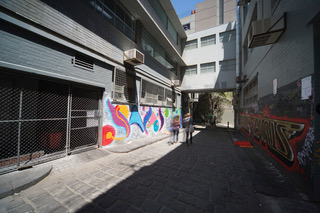By Dr Jordan Lacey
Feeling swamped and overwhelmed by the modern city has become a typical human sensation. At times, it can feel as if there is no room for ourselves – our voices – within the cacophony of noises, speeds and intensities that define our daily experiences. Urban spaces have come to act primarily as zones of functionalism – commute, consume, work, and in some cases (thankfully) play. The further we push to the edges of our city, the more functional our spaces become: streets are almost empty, except for those driving to work or their local shopping centres. There is little other activity, outside of people’s homes. The reasons for this are clear: for those living, for instance, on the south-eastern edge of Melbourne, a two-hour commute to work is not uncommon. How can anyone find the time for play, community or public interaction in these conditions?
This can feel like a hopeless situation – we all know about these urban fringe issues, and yet little is done to resolve them. Cities continue to grow outwards, and rapidly, without the aftermath of alienation and disconnection that beleaguers our communities ever becoming a serious enough concern to warrant a change in practice; each new suburb added to the urban fringe, reflects those already built. What possible role can the artist play in such conditions? We are not in the business of improving infrastructures or providing essential services – rather we provide alternative experiences, conceptual or sensory, and new ways of encountering the world.
Artists have a critical role to play in advocating for communities. It is incumbent upon us to step outside of our typical working processes – often self-guided and idiosyncratic – by conjoining with communities to produce artworks that have or provide meaning not just for the artist, but for the community who lives with the artwork. For my practice, an entry point to consider this is to remember that everyone has a voice – a story to be told. Indigenous artists, including Vicki Couzens and Ron Murray speak of deep listening: this is an ancient (and continuing) Aboriginal practice of nurturing relationships through respectful listening. In my own practice this involves recording stories, voices, and even environmental sounds that reflect the narrative of a person’s experiences. These stories can be woven back into the landscape – via an artwork – to articulate those surrounding stories so often unheard: creating environments of deep listening that imbue the modern landscape with meaningful narratives.

Touchstone: The artwork remembers. Each dawn and dusk the artwork performs a song to the community, which is generated by the number of times a central ‘sensing stone’ is touched the previous day. The artwork was funded by the City of Casey. Image © Ross McLeod.
I am working with a council at the moment to record songs and chants of each language group in their suburb. In the morning, our artwork, Touchstone, sings these recordings to anyone who might be present – a celebration of the dawn. Voices mix in with other environmental recordings of the suburb, recorded in collaboration with community members. It builds on a previous artwork of mine, Revoicing the Striated Soundscape, which gave air-conditioners new and playful voices as a means to create a “sonic rupture”. A sonic rupture, as discussed in my creative practice book, is a zone in which city dwellers experience typical mundane occurrences as unexpected and imaginative encounter. This is art as celebration of human presence, aiming to create points of meaning for local people.

Revoicing the Striated Soundscape. Four speakers installed inside readymade air-conditioners, play reprocessed air-conditioning and other site-specific sounds, recorded previously in the same location. Image © Carla Gottgens.
This method of working is processual. A process enables consultation, communication and co-collaborative outcomes, essential if the community are to own the artwork as much as the artist. A challenge for the creative practice artist who wants to engage in process is how to work with council bureaucracies that may be more confident in funding a fully-formed idea than an ongoing process. Of course, this is not always a problem. In regard to the above examples, I experienced no such impediment. However, when facing this conundrum, the artistic researcher must articulate both their process and their idea, which is difficult if agencies do not recognise that innovative ideas emerge from creative processes. However, it is essential that artistic researchers find a way to communicate this if we are to be part of empowering community with voice. And while we know such artistic intent won’t resolve the pressures of contemporary life, it may at least provide some sense of empowerment and belonging within the places we inhabit.
Dr Jordan Lacey is coming to the end of his vice-chancellor’s postdoctoral research fellowship, and is preparing to transition into a teaching-research position in RMIT’s School of Design. During his research Jordan developed new methods for applying sound installations as a creative tool for transforming the experience of urban spaces. His approach can be considered a part of an international push towards the establishment of new urban natures. For further information see his website and recent articles for The Conversation.